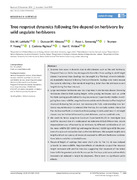| dc.description.abstract | 1. Savanna tree cover is dynamic due to disturbances such as fire and herbivory. Frequent fires can limit a key demographic transition from sapling to adult height classes in savanna trees. Saplings may be caught in a ‘fire trap’, wherein individuals repeatedly resprout following fire top-kill events. Saplings only rarely escape the cycle by attaining a fire-resistant height (e.g. taller than the minimum scorch height) during fire-free intervals. 2. Large mammalian herbivores also may trap trees in shorter size classes. Browsing herbivores directly limit sapling height, while grazing herbivores such as cattle facilitate sapling growth indirectly via grass removal. Experimental studies investigating how meso-wildlife, megaherbivores and domestic livestock affect height of resprouts following fire are rare, but necessary for fully understanding how herbivory may reinforce (or counteract) the fire trap. In our study system, interactive fire–herbivore effects on transitions from sapling (<1 m) to adult tree (>1 m) height classes may be further influenced by plant defences, such as symbiotic ants. 3. We used the Kenya Long-term Exclosure Experiment (KLEE) to investigate how post‐fire resprout size of a widespread monodominant East African tree, Acacia drepanolobium was influenced by (a) herbivory by different combinations of cattle, meso-wildlife (15–1,000 kg) and megaherbivores (>1,000 kg) and (b) the presence of acacia–ant mutualists that confer tree defences. We sampled height, stem length and ant occupancy of resprouts exposed to different herbivore combinations before and after controlled burns. 4. Resprout height of saplings that were short prior to fire (<1 m) was reduced primarily by meso-wildlife. Negative effects of elephants on post-fire resprout height increased with pre-fire tree size, suggesting that resprouts of the tallest trees (with the greatest potential to escape the fire trap cycle) were preferentially browsed and reduced in height by elephants. There were no significant cattle effects.
5. Synthesis. We provide experimental evidence for two potential pathways through which large herbivores exert control over sapling escape from the fire trap: (a) post-fire meso-wildlife browsing of short (<1 m) resprouts and (b) elephant browsing of the largest size class of resprouts, which would otherwise be most likely to escape the fire trap | en_US |
